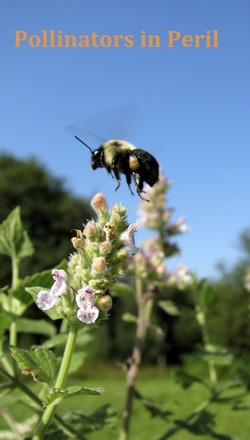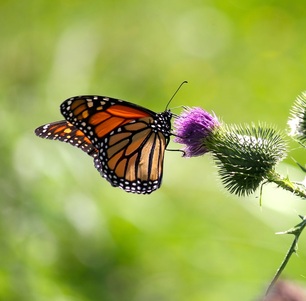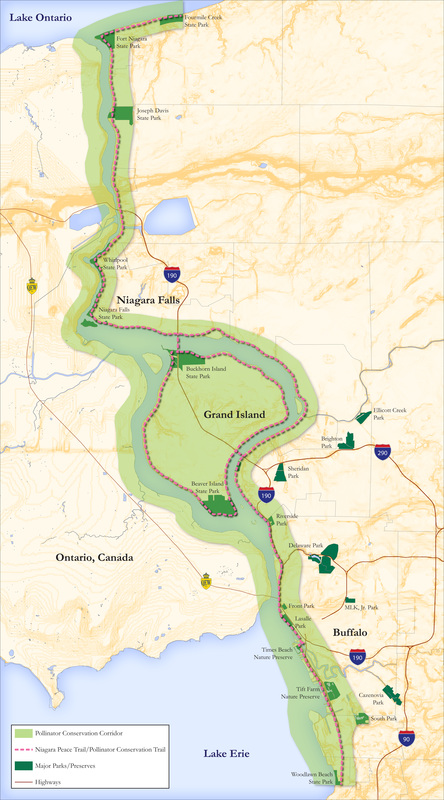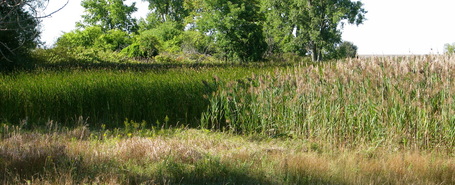The Friends of Times Beach Nature Preserve
Butterflies, Insects, Bugs, Spiders, and Pollinator Conservation
Butterflies, pollinators, insects including native bees, beetles, and other bugs are important parts of the ecology of The Times Beach Nature Preserve. Many of the flying insects observed flying over the pond on a summer day or evening are an important part of the food chain for bird species including warblers, swallows, woodpeckers, and so many more. Insect larvae including those in the water, or in the leaf litter or beneath tree bark are also critical food sources. Many native pollinators including a variety of native bees are found at Times Beach. Damselflies and Dragonflies can be found throughout the Nature Preserve. Butterflies have always been abundant at Times Beach. They depend upon host plants where they lay their eggs and upon which the hatched larvae feed. Flowering plants sustain the adults, especially late in the season. Monarch Butterflies, a vanishing species now being evaluated for protection by the Endangered Species Act were once abundant at Times Beach. The host plant for this butterfly is the common milkweed. Flowering plants for the adults include native asters, and goldenrods. We are working to restore the habitats for these many important parts of our biodiversity. the Monarch Butterfly has been named as one of Times Beach Nature Preserves first class of Iconic Species. Read more about that here.

The Collapse of Pollinator Ecosystems A decade ago, Colony Collapse Disorder (CCD) began to infect honey bee colonies around the globe. First reported in North America in 2006, it ushered in precipitous declines in Honey Bee populations. Recovery is a challenge. Recently CCD has been strongly linked to pesticide's that are widely used. One class of these pesticides, neonicotinoids have been strongly implicated. Since the publication in 1962 of Rachel Carson's "Silent Spring", the impact of pesticides on wildlife has been recognized as an important contributor to ecosystem stress, and species collapse. The use of pesticides on and "in" plants, (compliments of genetic engineering), characterize our contemporary environment. Industrial agriculture, non-organic farms, and the maintenance practices and habits regarding lawns, gardens, the landscapes of roadways, parks and other public and private spaces all contribute to an overwhelming chemical diet that all life is now exposed to. Other contributors to pollinator conservation issues include habitat loss, other chemicals including vehicle, roadway, and household chemicals and cleaners, waste, water treatment, air born pollution, development, deforestation, expanded industrial agriculture, and climate change. Pollinators as Metaphor Pollinators are basically animals which are dependent on plants and flowers, and provide services to help those plants reproduce. Pollinator conservation is an overarching way to describe conservation of pollinators, pollinator insects, other insects, bugs, spiders, and much more. The interconnected web of life in an ecosystem is all at risk when species decline. All plants and animal organisms are an essential part of ecosystem health. Pollinator conservation is a metaphor and a platform to engage in ecosystem conservation. The Friends of Times Beach are strong advocates of pollinator and ecosystyem conservation. We are working on projects that involve "habitat gardening" and the planting of native species in the preserve, throughout our outer harbor, and throughout the Niagara River Corridor. If you would like to donate, please go to the donation button at the top of this webpage. Links and ResourcesColony Collapse Disorder Watch the Film: Vanishing of the Bees Article: Scientists May Have Finally Pinpointed What's Killing All The Honeybees Business Insider 13 May 2014 Reports Harvard Study May 2014 Sub-lethal exposure to neonicotinoids impaired honey bees winterization before proceeding to colony collapse disorde National Resources Defense Council Vanishing Bees Page European Food Safety Authority identifies CCD link to pesticides Xerces Link to White House Council on Environmental Quality October 2014 Report Supporting the Health of Honey Bees and Other Pollinators |
Coming Spring 2016
|


